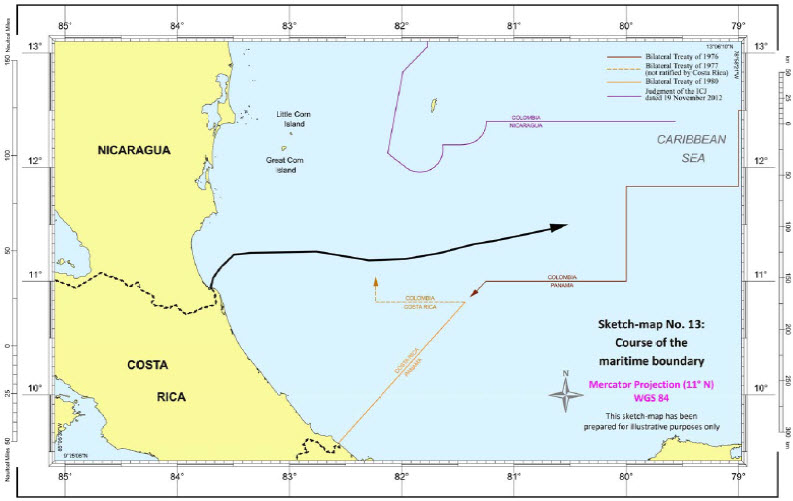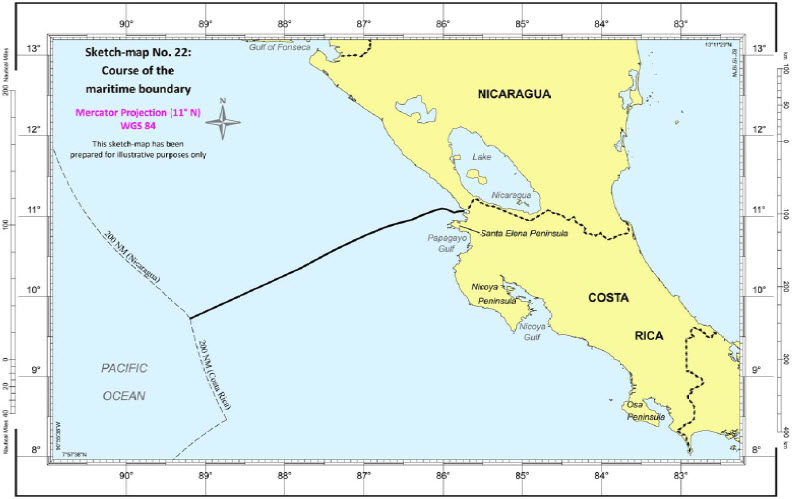The first part of the decision deals with the case relating to the land boundary, which in its view could have implications for the delimitation of the maritime boundary in the Caribbean Sea. After having recalled its analysis of the 1858 Treaty of Limits between the parties (see Certain Activities Carried Out by Nicaragua in the Border Area (Costa Rica v. Nicaragua), ICJ, 2015) and examined the reports of the experts appointed by the Court, the Court concluded that Costa Rica had sovereignty over the whole of Isla Portillos (with the exception of the enclave of the Harbor Head Lagoon and the sandbar separating it from the Caribbean Sea) up to the sandspit bordering the San Juan River at its mouth (i.e., the point at which the right bank of the San Juan River reaches the low-water mark of the coast of the Caribbean Sea). The Court consequently considered that Nicaragua violated Costa Rica’s territorial sovereignty and ordered that the military camp established by Nicaragua on the beach of Isla Portillos be removed. Such declaration and order constitute "appropriate reparation" according to the Court.
The Court then turned to the delimitation of the single maritime boundaries between the two States in the Caribbean Sea on the one hand and the Pacific Ocean on the other hand, delimiting all the maritime areas appertaining to each of them.
Delimitation of the territorial seas
The Court delimited the territorial sea boundaries in both the Caribbean Sea and the Pacific Ocean by applying the two-step reasoning of Article 15 of UNCLOS: first, it drew a provisional equidistance line and second, it examined the existence of any special circumstance justifying the adjustment of the line.
Regarding the boundary in the Caribbean Sea, the Court considered that the high instability and narrowness of the sandspit near the mouth of the San Juan River prevented it from placing a base point there and that the first segment of the maritime boundary would therefore follow a line drawn between the point on solid land on Costa Rica’s coast, which is closest to the mouth of the river (point Pv), and the fixed point at sea at a distance of two nautical miles from the coast on the median line (point FP). The boundary would then follow an unadjusted median line. The Court dismissed the circumstance invoked by Nicaragua on grounds of concavity of its coasts and did not grant any maritime space to the enclave of the Harbor Head Lagoon.
Regarding the boundary in the Pacific Ocean, the Court identified no special circumstance and therefore drew a strict equidistance line.
Delimitation of the exclusive economic zones and the continental shelves
In delimiting the exclusive economic zone and the continental shelf both in the Caribbean Sea and the Pacific Ocean, the Court used the well-established three-stage method of equidistance/relevant circumstances. After having drawn strict equidistance lines, the Court adjusted them by giving half effect only in the delimitation to:
- Nicaragua's Corn Islands, located in the Caribbean Sea, given their limited size and significant distance from the Caribbean mainland coast;
- the Santa Elena Peninsula, located in the Pacific Ocean, since their effect on the provisional equidistance line was disproportionate and would result in a significant cut-off of Nicaragua’s coastal projections.
The Court concluded by considering that the maritime boundaries established between Costa Rica and Nicaragua in the Pacific Ocean and the Caribbean Sea did not result in gross disproportionality and achieved an equitable solution.
For the Court’s judgment and the judges' declarations and separate opinions, please click here.








